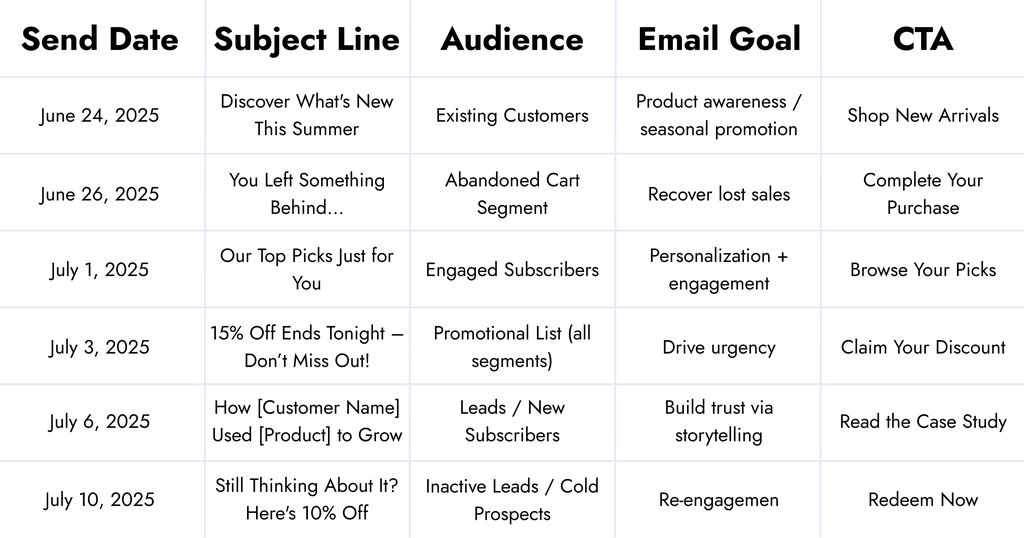Are your emails just floating out there, hoping to catch someone’s eye? Maybe your email marketing ROI isn’t quite where you want it. You’re not alone! Sending emails without a solid strategy is a common problem, leading to lost chances to truly connect with your audience, turn those leads into paying customers, and ultimately, increase your revenue.
A roadmap to ensure your emails hit the mark every time? That’s exactly what a monthly email calendar is all about.
Consider this blog your guide to crafting an email campaign plan that converts. Whether you’re focused on email marketing for eCommerce or any other business, you’ll learn everything from setting goals to tracking performance.
Here’s what you’ll discover:
- Why a monthly email calendar is a game-changer for engagement.
- How to pinpoint your ideal audience and marketing goals.
- The types of emails that deserve a spot in your email calendar.
- How to weave your email efforts into your complete marketing strategy.
- The secrets to writing killer subject lines and CTAs.
- How to track what’s working (and what’s not) and refine your approach.
Ready to revolutionize your email marketing? Let’s get started!
Benefits of Having a Monthly Email Calendar

Think of aimless email marketing as randomly scattering seeds and hoping for flowers. An email calendar? Now that’s a carefully cultivated garden. Here’s what it brings to the table:
- Stay Organized & Proactive: No more last-minute scrambles! Get your marketing services in order and stay ahead of the curve.
- Consistent Engagement: Regular, relevant emails build loyalty and help you grow your audience.
- Align with Business Goals & Trends: Easily tie your emails to what’s happening in your business, like product releases or seasonal sales.
- Prevent Content Gaps: Keep the conversation flowing with consistently valuable information.
- Data-Driven Refinement: See what resonates with your audience and boost your email marketing ROI with every send.
Define Your Email Marketing Goals

Before you even think about an email planning template, ask yourself: What do I want my email campaigns to achieve? Defining these objectives is key. Here are a few common goals:
- Brand Awareness: Introduce your brand’s personality and values.
- Promotions & Sales: Drive revenue with enticing offers and discounts.
- Product Education: Show customers how to get the most out of your products.
- Customer Retention & Loyalty: Turn one-time buyers into lifelong fans.
- Newsletter Engagement: Encourage readers to actually read and interact with your newsletter.
- Event Participation/Seasonal Campaigns: Promote upcoming events or capitalize on seasonal trends.
Specific goals shape everything, from your email content to your targeting strategy. They also help you determine what kind of marketing services are the best fit for your business.
Understand Your Audience and Segments
Treating all customers the same is a recipe for disengagement. Knowing who you’re talking to is crucial. Tailored messages = better results. Think about these segments:
- New Subscribers: Give them a warm welcome and highlight key offers.
- Loyal Customers: Reward their loyalty with exclusive perks.
- Lapsed Users: Lure them back with personalized deals or reminders of what they’re missing.
Personalized emails feel relevant, resulting in higher click-through rates and a healthier email marketing ROI. A quick promo might work for existing customers, but new subscribers will likely appreciate an informative newsletter.
Determine Your Ideal Email Frequency
So, how often should you send emails? There’s no magic number, but understanding the impact of frequency is vital. Too infrequent, and you risk being forgotten. Too frequent, and you’ll annoy people into unsubscribing.
- Weekly: Great for staying top-of-mind with regular updates and promotions.
- Bi-Weekly: A good balance for delivering valuable content without overwhelming subscribers.
- Monthly: Best for longer-form content and less frequent updates.
The best frequency depends on your industry and audience. For example, an email marketing for eCommerce business might send promotions more often than a SaaS company sharing educational content. The key is to strike the right balance, keeping your audience engaged without being a nuisance.
Types of Emails to Include in Your Calendar
Mix it up! A good email calendar includes a variety of content to keep things fresh:
- Welcome Emails: Set the tone for your brand and what subscribers can expect.
- Product Updates: Share news about new features, updates, or integrations.
- Promotional Offers & Sales: Drive sales with coupons, deals, and limited-time offers.
- Newsletters: Share industry insights, company updates, and helpful resources.
- Customer Success Stories/Case Studies: Showcase how your products solve real-world problems.
- Educational/Blog Content: Share valuable content relevant to your industry.
- Event Invitations/Reminders: Promote upcoming events and webinars.
- Holiday/Seasonal Content: Connect with prospects during relevant times of the year.
- Re-engagement Emails: Win back inactive subscribers with exclusive promotions.
Build a Sample Monthly Email Calendar
Here’s a peek at what a monthly email calendar might look like, to help you kickstart your strong email campaign:
- Week 1: Share industry news and educational content in a newsletter.
- Week 2: Highlight a specific product feature and its benefits.
- Week 3: Run a sale with discounts on popular items.
- Week 4: Offer a free resource (like an e-book or blog article) and tease an upcoming event.
You can use tools like Google Sheets, Airtable, or email marketing service platforms like Mailchimp and Klaviyo to create and manage your calendar.
As a Mailchimp and Klaviyo certified partner and expert, Digilite can help you set up, optimize, and manage your email marketing campaigns effectively using these platforms.
See how our strong email campaign boosted the open rate by 40%.
Here’s a basic example of how you can lay out your spreadsheet:

Align Email Topics with Other Marketing Activities
For maximum impact, weave your email campaigns into your other marketing efforts.
- Social Media: Promote email content (like blog posts) on social media.
- Product Launches: Announce new products via email to drive initial sales.
- Sales Events: Coordinate your email marketing with online and offline sales.
- Webinars: Promote upcoming webinars and send follow-up emails to attendees and those who missed out.
- Content Marketing: Deliver your e-books and blog content via email.
Write Subject Lines and CTAs That Drive Engagement
Subject lines are your first impression. Here’s how to nail them:
- Keep it short: Aim for under 50 characters.
- Create urgency: Use words like “Last chance” or “Limited time.”
- Personalize: Include the recipient’s name or company.
- Ask a question: Spark curiosity and encourage openness.
- Use numbers: Data-driven subject lines often grab attention.
Calls-to-action (CTAs) need to be clear and compelling. Tell subscribers exactly what you want them to do!
- Use action verbs: “Join Now,” “Learn More,” “Shop Now.”
- Highlight value: “Join Our VIP List,” “Get Your Exclusive Discount.”
- Make them visual: Use buttons and contrasting colours to make CTAs stand out.
A/B testing is your friend! Experiment with different CTAs and subject lines to see what resonates best. Remember, a powerful CTA combined with a well-crafted email planning template is a winning combination.
Track Performance and Optimize Over Time
Email marketing is an ongoing process of learning, testing, and refining. Track these key metrics:
- Open Rate: Percentage of subscribers who opened your email.
- Click-Through Rate (CTR): Percentage of subscribers who clicked a link.
- Conversion Rate: Percentage of recipients who completed a desired action (e.g., signing up for a course, making a purchase).
- Unsubscribe Rate: Number of subscribers who opted out of your list.
If an email is underperforming, dig into why. Is the timing off? Is the messaging irrelevant? Use your insights to tweak your campaign and improve your email marketing ROI. Consider revising your frequency or audience segmentation.
Platforms like HubSpot, Klaviyo, and Mailchimp offer built-in analytics to help you track performance.
Tips for Staying Consistent Month After Month
Consistency is key! Use these tips to streamline your workflow and stay on track:
- Batch Create Content: Dedicate time each month to create multiple emails at once.
- Use Templates: Create a consistent look and feel with email design templates.
- Delegate and Schedule: Assign tasks and set deadlines for your team.
- Set Calendar Reminders: Schedule reminders to prepare your emails in advance.
- Automate Sends: Schedule your emails to be sent automatically.
A monthly email calendar is an essential tool for building a strong email campaign, boosting customer engagement, and maximizing your email marketing ROI. Start planning, organizing, and tracking your results, and you’ll transform your email marketing from a shot in the dark to a powerful growth engine.
Start small, experiment, and always focus on providing value to your audience. And if you’re still feeling overwhelmed, consider getting in touch with companies offering competent marketing services. Take the first step today!
Ready to take your email marketing to the next level?




